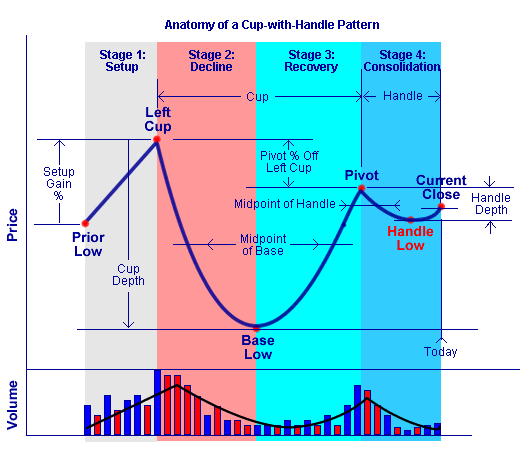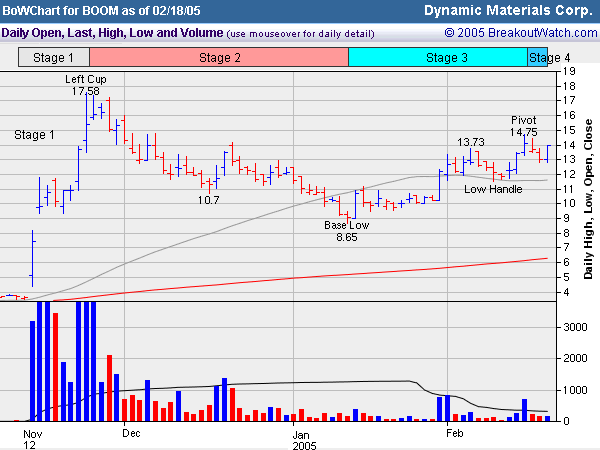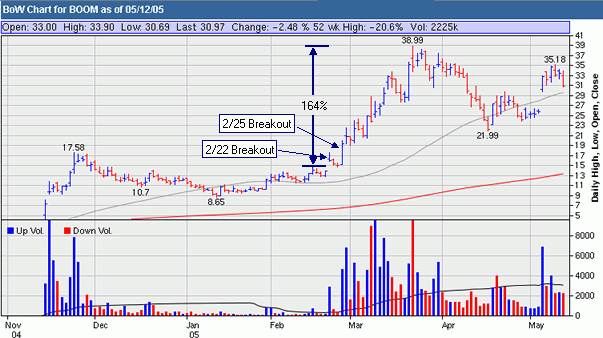Anatomy of a Cup-with-Handle Chart Pattern
This article considers why a cup with handle forms, the desirable features of the pattern and how we select them. We will also look at an example of one of the best performing cup-with-handle formations recently.

Stage 1: Setup. The pattern starts with a stock rising from a former base. At some point, profit taking sets-in and the stock begins to decline, ending the setup. The maximum price reached at the end of Stage 1 is called the 'Left Cup', and the amount by which the stock rose from its prior low is the Setup Gain. To ensure a well-defined left cup, we require that the setup gain be at least 30% from the prior low level for it to qualify as a valid left cup.
Stage 2: Decline. The stock now collapses into a new base. The collapse can occur for any number of reasons: poor company results; over-all market conditions; bad news; profit taking after a strong setup stage, and so on. There should be strong selling and volume should be well above average for the first few days of the collapse. Note that collapsing price alone is not sufficient to provide a good CwH pattern, volume is also important. This is because we want most of the buyers from the setup stage to liquidate their holdings, so there will not be a lot of overhead supply when the stock begins to climb the right side of the cup. The combined price and volume action in stage 2 is important if the eventual breakout is to succeed. By the end of stage 2, volume should have fallen to well below average levels as most holders have sold and there is little buying activity, if any. The depth of the base is important also. We do not want the stock to collapse to a level from which recovery will be difficult, if not impossible, so when selecting CwH stocks for our watchlist we limit the cup depth to be at most 60% of the left cup price.
Stage 3: Recovery. If and when the conditions that brought about the stage 2 collapse have been resolved, the stock may begin to recover. If it does so, the stock will start to climb the right side of the cup. As it does so, we like to see above average volume on days when the price moves up, which indicates that institutions are taking an interest in the stock, but light volume on days when it closes down, indicating that there are small numbers of sellers. Ideally, this constructive price and volume action will strengthen as the right side of the cup is formed and the stock moves higher. Meanwhile, there will be some holders of the stock who bought at or near the left cup price but didn't sell in stage 2. These holders are waiting for the time when they can recoup some or all of their losses. There will also be profit taking by bottom-fishers. As losses are covered or profits are taken there will be pauses in the recovery and a typical cup right-side will exhibit a stair-step characteristic, rather than the smooth ascension shown in the idealized chart. Each of these pauses, or pullbacks, reduces the overhead supply left over from the left cup setup.
As the price on the right side approaches the left cup level, the last holders will finally decide to cut their losses and there will be a large volume sell-off. This often is preceded by a day on which the price spikes on high volume which the sellers have interpreted as an overbought condition and therefore a last opportunity to recoup their losses. This is the point at which the pivot forms, and marks the end of the recovery stage.
There are several technical conditions that must be met before our algorithm will recognize a valid pivot. Firstly we want the stock to have attained a strong relative strength when compared to all other stocks, so we require an RS of 70 on a scale from 1-99. We also want the pivot to be approaching the left cup level, so we require the pivot price to be at least 60% of the left cup. Thirdly, there must have been sufficient time for a shakeout of holders during stage 2, and sufficient time for institutions to notice and take an interest in the stock during stage 3. This is essential if the stock is to be projected to new highs after the breakout. Consequently, we require the distance from the left cup to the pivot, to be at least 6 weeks (30 sessions). On the other hand, we don't want the cup to be so long as to be meaningless, so there is a maximum cup length of 325 sessions imposed. A complete list of our criteria is provided at the end of this article.
We mentioned above the need for constructive price/volume action while the stock is building the right side of its cup. This is measured by our Right Cup Quality indicator (RCQ) and is a component of our overall Chart Quality metric (CQ). CQ is described here.
Stage 4: Consolidation. After the pivot we want and expect to see a shakeout while the overhead supply is depleted. This will cause the price to decline, initially on high volume but then the price should stabilize or drift down on volume well below average levels. The institutions who are tracking the stock know that they want the overhead supply eliminated and will wait for these stable conditions to materialize before they pounce. To identify well behaved handles, we require that the decline (or 'droop') in the handle should not be more than 30% of the pivot price, that the mid-point of the handle be above the mid-point of the base and that the minimum time spent in the handle should be two days, but that the overall handle length should not be more than 90 days. We also do not want the handle to be disproprtionate to the cup, so we require that the handle be no longer than a third of the cup length. The two day handle minimum is quite short but we want to make sure we don't miss any strong candidates (as will be seen shortly). We give our subscribers the ability to filter out short handles if they wish.
We measure the price/volume action in the handle using a proprietary metric called Handle Quality (HQ), which is also a component of CQ, mentioned earlier.
After the price has stabilized, it is not uncommon to see the price begin to rise on higher volume. This is an indication that institutions are starting to nibble and may indicate a strong breakout to come. We have noticed that breakouts are 17% stronger, on average, when the price and volume rise on the day before the breakout. See our newsletter of 4/23/05.
When the conditions described in these 4 stages are satisfied, we have a valid CwH pattern and the stock will be placed on our CwH watchlist, CwHWatch. If the conditions change so the stock no longer meets the criteria, then the stock will be dropped from CwHWatch. We monitor the stock while it is on CwH Watch and issue a real-time alert if the pivot price is met or exceeded and the projected daily volume exceeded 1.5 times the average daily volume - an indication that institutions are buying the stock in large quantities.
A CwH Example: Boom
On November 12, 2004, Dynamic Materials reported earnings of 16 cents a share compared to a loss of 13 cents a share for the same quarter a year earlier, and predicted strong future earnings based on order backlogs (see story). The stock went from $3.66 to $17.58 (a 380% gain) in the next 8 sessions, completing its stage 1 setup. The stock then entered the stage 2 decline as profit taking took over and after one failed recovery attempt the stock lost almost 50% of its value. At its low, volume was well below the average and had almost returned to the pre-November12 levels. The recovery then began with constructive price/volume action as needed. As price and volume picked up, the stock formed a low handle with pivot at 13.73. The mid-point of this handle was below the mid-point of the base, however, so it did not qualify for our CwHWatch. A valid pivot did form on Feb. 15 at 14.75 with positive HQ and RCQ values and our Expected Gain model predicted a gain of 66% if the stock broke out. On February 18 the stock indicated it was ready to move higher when it closed at its high of the day. After the long weekend it gapped up at the open by more than $2 and broke out on nearly 8 times average daily volume. It formed a second short handle and broke out again on 2/25 on 10 times average daily volume and went on to gain 164% in the next month.
Cup-with-Handle Chart for BOOM as of 02/18/05

Cup-with Handle Chart for BOOM as of 5/12/05 showing progress since breakout.
